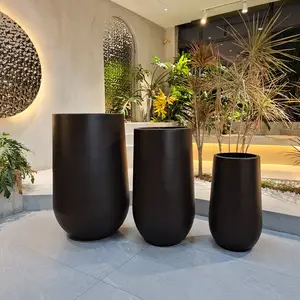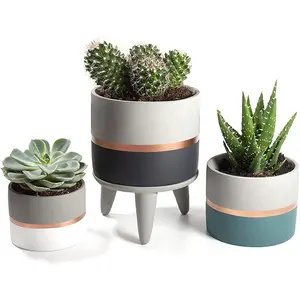

Tall Outdoor Decorative Durable Large Fiber Clay Cement Flower Pots & Planters Pot For Planting Trees And Flowers

















Welcome to the world of cement flower pots, a rising trend in outdoor home decorating. These unique and versatile planters are not only aesthetically pleasing but also durable, offering a modern touch to your garden. Whether you're looking to fill an empty space or expand your garden, cement flower pots are an excellent choice. Their neutral color and geometric forms blend beautifully with various materials, and their DIY potential allows for a multitude of personalization options. Let's delve into the aesthetic appeal of these planters, their environmental impact, and how to choose the right ones for your garden.
Concrete planters, also known as cement flower pots, are gaining popularity in outdoor home decorating. Their unique aesthetic appeal and versatility make them an excellent choice for garden styles. The neutral color of concrete allows for designing geometric forms and pots in free shapes, blending beautifully with wood, metal, rocks, and bricks. DIY concrete designs offer many different shapes, styles, and sizes, adding a modern look and contemporary feel to outdoor home decorating. These planters are not only stylish but also durable, hard-to-break, and can withstand varying weather conditions.
Why choose cement flower pots? The answer lies in their durability, insulation, and size. Concrete planters are long-lasting and can withstand elements such as wind or rain, ensuring your plants are safe. They offer insulation, keeping the soil warm during cold weather and preventing water leakage. For larger plants and trees, their weight and volume make them an ideal choice. These planters can expand the size of your garden or fill empty space in your home, creating an elegant atmosphere.
Concrete planters, or cement flower pots, are renowned for their durability and versatility. They are long-lasting and can withstand elements such as wind or rain, ensuring your plants remain safe and secure. Concrete's weight makes these planters stable and less likely to be knocked over. Additionally, they are versatile in terms of size, making them ideal for heavier plants and trees that require a deep vessel for root growth. Despite their weight, our unique formula ensures they are not completely immovable.
Cement flower pots, especially DIY ones, offer a unique aesthetic appeal that can't be matched by other materials. They are chic and versatile, allowing for a multitude of personalization options. You can paint them after drying for a consistent color, or leave them in their natural state for a more rustic look. Their rough, textured finish can add an interesting visual element to your garden. Moreover, the satisfaction of creating your own designs and seeing them come to life adds to their appeal. The cost-effectiveness of these DIY pots, compared to store-bought ones, is an added bonus.
Concrete planters are long-lasting and environmentally friendly investments. Concrete is heavy and able to withstand elements such as wind or rain, making it a durable choice. In addition, because concrete’s color is uniform, your planter won’t be any less visually appealing in the event of it ever getting chipped or damaged. The density of concrete promotes insulation and will keep the soil surrounding your plants warm during cold weather, contributing to a healthy plant environment.
Choosing the right cement flower pots for your garden involves considering several factors. Cement, a heavy material, is best placed where it will remain before filling with soil and plants. It's important to ensure there's a drain hole at the bottom of the pot. Cement can be mixed and poured into various shapes and sizes, offering versatility for your garden design. It can also be painted in different colors to match your aesthetic preferences. Remember, due to its weight, moving a cement planter can be challenging once it's filled.
The size and shape of your cement flower pots directly impact the growth and health of your plants. A pot that’s too small can stunt growth, while an oversized planter can lead to nutrient imbalance and root rot. Therefore, choosing the right size is crucial. A quick rule of thumb is to select a pot diameter that’s roughly two inches larger than the plant's own diameter. Also, consider the pot shape. Different plants require different pot depths depending on their root size. For instance, succulents thrive in shallow, wide pots, while larger herbs and shrubs need taller pots.
Cement flower pots, particularly the ever-popular round planters, come in a variety of colors and textures. You can choose from shades like Dove Gray, Light Brown, Sand Tan, and Terra Cotta. The texture options include Durabrite, Lt. Sandblast, and Permastone. The exposed aggregate texture is washed, cured, and sealed to enhance the stone colors. The smooth surfaces have color dyes throughout the mixture for consistent color and a protective sealer that prevents dusting. These variations allow you to select the perfect pot that complements your garden's aesthetic.
Outdoor home decorating looks creative and stylish with concrete planters. You can choose to make classic, geometric, modern, and creative planters for your beautiful flowers or small plants. Concrete planters are heavy. You need to choose a location to make a container and place it somewhere before pouring down the soil for flowers. It is nearly impossible to move large pots later. Check out the inspiring design ideas and look for a unique way to add DIY pots with flowers to your outdoor home decorating.
A well-placed cement flower pot can serve as a spectacular focal point in your garden. It can turn a monotonous expanse of patio into the stage for a botanical show. A container can make a ho-hum border settle into perfection, give a long pathway an exciting destination, and lift the eye by adding structure and interest. It can also be used to make the best of an eyesore, highlight a plant’s peak season, fill up a blank wall, emphasize a sight line, and create a centerpiece. Imagine your garden without this container, the results might surprise you.
Integrating cement flower pots with other garden elements can significantly enhance the aesthetic value of your outdoor space. Concrete planters, available in a vast array of sizes, styles, patterns, and colors, can be combined in various ways to create a stunning visual impact. You can match these planters with architectural pavers for a cohesive look that will surely impress. Their versatility allows them to blend seamlessly with patios, building entrances, and parkways, making them a dependable and cost-effective choice for any garden project.
Cement flower pots have emerged as a stylish, durable, and versatile choice for garden enthusiasts. Their unique aesthetic appeal, coupled with their durability and insulation properties, make them an ideal choice for any garden. The freedom to choose the size, shape, color, and texture of these pots allows for a high degree of personalization, ensuring that they blend seamlessly with your garden's aesthetic. Furthermore, their ability to serve as focal points and integrate with other garden elements enhances the overall visual impact of your outdoor space. In conclusion, cement flower pots are a long-lasting, environmentally friendly, and cost-effective solution to revamp your garden and create an elegant atmosphere.